
PRISM (Power Reactor Innovative Small Module, sometimes S-PRISM from SuperPRISM) is a nuclear power plant design by GE Hitachi Nuclear Energy (GEH).

PRISM (Power Reactor Innovative Small Module, sometimes S-PRISM from SuperPRISM) is a nuclear power plant design by GE Hitachi Nuclear Energy (GEH).
The S-PRISM represents GEH's Generation IV reactor solution to closing the nuclear fuel cycle and is also part of its Advanced Recycling Center (ARC) proposition [1] to U.S. Congress to deal with nuclear waste. [2] S-PRISM is a commercial implementation of the Integral Fast Reactor developed by Argonne National Laboratory between 1984 and 1994.
It is a sodium-cooled fast breeder reactor, based on the Experimental Breeder Reactor II (EBR-II) design, scaled up by a factor of ten. [3]
The design utilizes reactor modules, each having a power output of 311 MWe, to enable factory fabrication at low cost.
In an identical fashion to the EBR-II that it is based on, the reactor would transition to a much lower power level whenever temperatures rise significantly, moreover the reactor vessel modules are pool type, as opposed to loop type, with the pool conferring substantial thermal inertia and the final key safety feature includes a "RVACS", which is a passive reactor vessel air cooling system to remove decay heat. These safety systems are passive and therefore always operate and are to prevent core damage when no other means of heat removal are available. [4]
As of 2022, the PRISM design is not under active consideration.
The integral fast reactor was developed at the West Campus of the Argonne National Laboratory in Idaho Falls, Idaho and was an extension (inc fuel reprocessing) to the Experimental Breeder Reactor II, which achieved first criticality in 1965 and ran for 30 years. The Integral Fast Reactor project (and EBR II) was shut down by the U.S. Congress in 1994. GEH continued work on the concept until 2001. [3]
In October 2010, GEH signed a memorandum of understanding with the operators of the Department of Energy's (DOE) Savannah River site, which should allow the construction of a demonstration reactor prior to the design receiving full NRC licensing approval. [5]
In October 2011, The Independent reported that the UK Nuclear Decommissioning Authority (NDA) and senior advisers within the Department of Energy and Climate Change (DECC) had asked for technical and financial details of the PRISM, partly as a means of reducing the country's plutonium stockpile. [6] In July 2012, GEH submitted a feasibility report to the NDA showing that the PRISM could provide a cost-effective way of quickly dealing with the UK's plutonium stockpile. The feasibility report includes an assessment from the consultancy firm DBD Limited suggesting there are "no fundamental impediment(s)" to the licensing of the PRISM in the UK. [7] [8] A 2012 Guardian article pointed out that a new generation of fast reactors such as the PRISM "could dispose of the waste problem, reducing the threat of radiation and nuclear proliferation, and at the same time generate vast amounts of low-carbon energy". David J. C. MacKay, chief scientist at the DECC, was quoted as saying that British plutonium contains enough energy to run the country's electricity grid for 500 years. [9] Recent announcements of planned expansion of nuclear power in the UK have made no reference to PRISM. [10]
In 2018 PRISM was selected by Battelle Energy Alliance to support the DOE decision making on the Versatile Test Reactor (VTR) program. [11] In February 2019, DOE expected to complete the initial stage of deciding whether to proceed with the VTR within a few weeks. [12] The VTR program was scrapped in 2022. [13]

A breeder reactor is a nuclear reactor that generates more fissile material than it consumes. These reactors can be fueled with more-commonly available isotopes of uranium and thorium, such as uranium-238 and thorium-232, as opposed to the rare uranium-235 which is used in conventional reactors. These materials are called fertile materials since they can be bred into fuel by these breeder reactors.
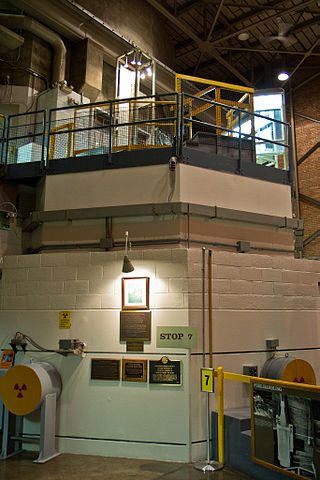
Experimental Breeder Reactor I (EBR-I) is a decommissioned research reactor and U.S. National Historic Landmark located in the desert about 18 miles (29 km) southeast of Arco, Idaho. It was the world's first breeder reactor. At 1:50 p.m. on December 20, 1951, it became one of the world's first electricity-generating nuclear power plants when it produced sufficient electricity to illuminate four 200-watt light bulbs. EBR-I subsequently generated sufficient electricity to power its building, and continued to be used for experimental purposes until it was decommissioned in 1964. The museum is open for visitors from late May until early September.

Dounreay is a small settlement and the site of two large nuclear establishments on the north coast of Caithness in the Highland area of Scotland. It is on the A836 road nine miles west of Thurso.
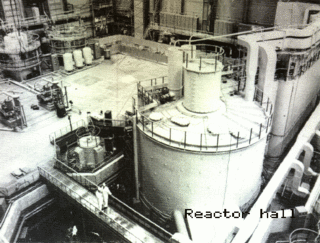
A fast-neutron reactor (FNR) or fast-spectrum reactor or simply a fast reactor is a category of nuclear reactor in which the fission chain reaction is sustained by fast neutrons, as opposed to slow thermal neutrons used in thermal-neutron reactors. Such a fast reactor needs no neutron moderator, but requires fuel that is relatively rich in fissile material when compared to that required for a thermal-neutron reactor. Around 20 land based fast reactors have been built, accumulating over 400 reactor years of operation globally. The largest was the Superphénix sodium cooled fast reactor in France that was designed to deliver 1,242 MWe. Fast reactors have been studied since the 1950s, as they provide certain advantages over the existing fleet of water-cooled and water-moderated reactors. These are:

Idaho National Laboratory (INL) is one of the national laboratories of the United States Department of Energy and is managed by the Battelle Energy Alliance. Historically, the lab has been involved with nuclear research, although the laboratory does other research as well. Much of current knowledge about how nuclear reactors behave and misbehave was discovered at what is now Idaho National Laboratory. John Grossenbacher, former INL director, said, "The history of nuclear energy for peaceful application has principally been written in Idaho".
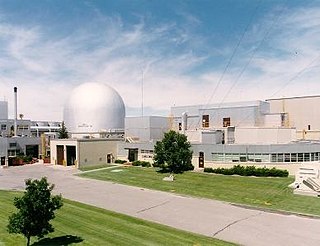
The integral fast reactor (IFR), originally the advancedliquid-metal reactor (ALMR), is a design for a nuclear reactor using fast neutrons and no neutron moderator. IFRs can breed more fuel and are distinguished by a nuclear fuel cycle that uses reprocessing via electrorefining at the reactor site.
Generation IVreactors are nuclear reactor design technologies that are envisioned as successors of generation III reactors. The Generation IV International Forum (GIF) – an international organization that coordinates the development of generation IV reactors – specifically selected six reactor technologies as candidates for generation IV reactors. The designs target improved safety, sustainability, efficiency, and cost. The World Nuclear Association in 2015 suggested that some might enter commercial operation before 2030.
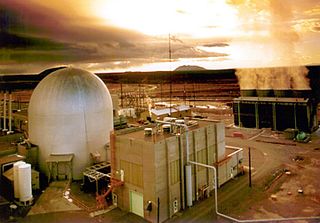
Experimental Breeder Reactor-II (EBR-II) was a sodium-cooled fast reactor designed, built and operated by Argonne National Laboratory at the National Reactor Testing Station in Idaho. It was shut down in 1994. Custody of the reactor was transferred to Idaho National Laboratory after its founding in 2005.

A sodium-cooled fast reactor is a fast neutron reactor cooled by liquid sodium.

The BN-350 was a sodium-cooled, fast reactor located at the Mangyshlak Nuclear Power Plant, located in Aktau, Kazakhstan, on the shore of the Caspian Sea.
A liquid metal cooled nuclear reactor, or LMR is a type of nuclear reactor where the primary coolant is a liquid metal. Liquid metal cooled reactors were first adapted for breeder reactor power generation. They have also been used to power nuclear submarines.

The Clinch River Breeder Reactor Project was a nuclear reactor project that aimed to build the USA's first large-scale demonstration breeder reactor plant. It was led by the U.S. Atomic Energy Commission. The project was opposed by President Carter.

The Zero Power Physics Reactor or ZPPR was a split-table-type critical facility located at the Idaho National Laboratory, Idaho, USA. It was designed for the study of the physics of power breeder systems and was capable of simulating fast reactor core compositions characteristic of 300-500 MWe demonstration plants and 1000 MWe commercial plants.
Pyroprocessing is a process in which materials are subjected to high temperatures in order to bring about a chemical or physical change. Pyroprocessing includes such terms as ore-roasting, calcination and sintering. Equipment for pyroprocessing includes kilns, electric arc furnaces and reverberatory furnaces.
Reactor-grade plutonium (RGPu) is the isotopic grade of plutonium that is found in spent nuclear fuel after the uranium-235 primary fuel that a nuclear power reactor uses has burnt up. The uranium-238 from which most of the plutonium isotopes derive by neutron capture is found along with the U-235 in the low enriched uranium fuel of civilian reactors.
The Reduced-Moderation Water Reactor (RMWR), also referred to as the Resource-renewable BWR, is a proposed type of light water moderated nuclear power reactor, featuring some characteristics of a fast neutron reactor, thereby combining the established and proven technology of light water reactors with the desired features of fast neutron reactors. The RMWR concept builds upon the Advanced Boiling Water Reactor and is under active development in theoretical studies, particularly in Japan. Hitachi and the Japan Atomic Energy Agency are both involved in research.
GE Hitachi Nuclear Energy (GEH) is a provider of advanced reactors and nuclear services. It is headquartered in Wilmington, North Carolina, United States. Established in June 2007, GEH is a nuclear alliance created by General Electric and Hitachi. In Japan, the alliance is Hitachi-GE Nuclear Energy. In November 2015, Jay Wileman was appointed CEO.

The BN-800 reactor is a sodium-cooled fast breeder reactor, built at the Beloyarsk Nuclear Power Station, in Zarechny, Sverdlovsk Oblast, Russia. The reactor is designed to generate 880 MW of electrical power. The plant was considered part of the weapons-grade Plutonium Management and Disposition Agreement signed between the United States and Russia. The reactor is part of the final step for a plutonium-burner core The plant reached its full power production in August 2016. According to Russian business journal Kommersant, the BN-800 project cost 140.6 billion rubles.
The CFR-600 is a sodium-cooled pool-type fast-neutron nuclear reactor under construction in Xiapu County, Fujian province, China, on Changbiao Island. It is a generation IV demonstration project by the China National Nuclear Corporation (CNNC). Construction started in late 2017. These reactors are expected to be connected to the grid in 2023 and 2025. The reactor will have an output of 1500 MW thermal power and 600 MW electric power. The fuel will be supplied by TVEL, subsidiary of Rosatom, according to the agreement signed in 2019.
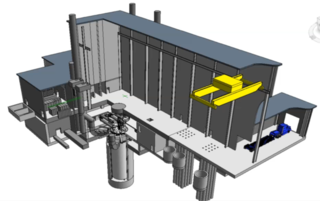
The Versatile Test Reactor (VTR) was a project by the U.S. Department of Energy to build a fast-neutron test reactor by 2026. Funding for the project was scrapped in 2022
{{cite journal}}: Cite journal requires |journal= (help)